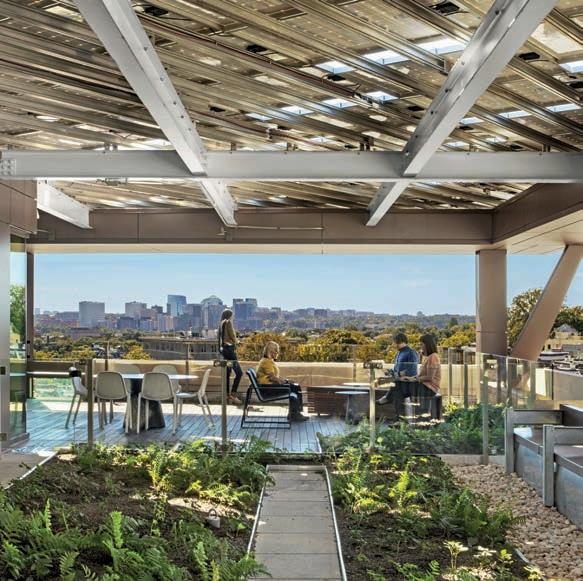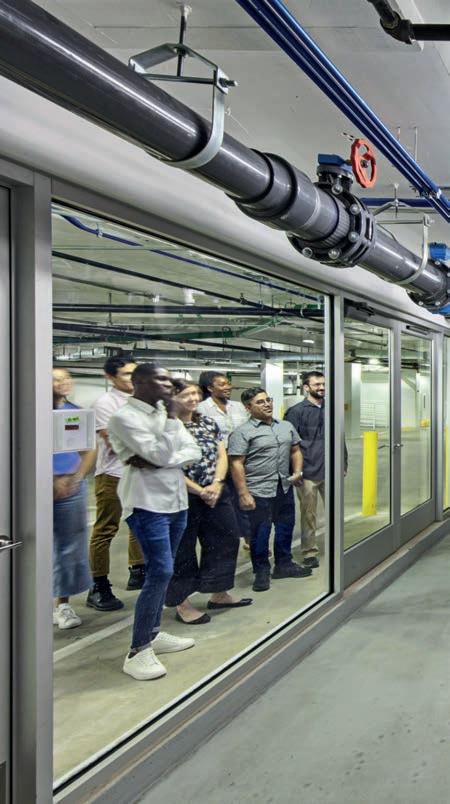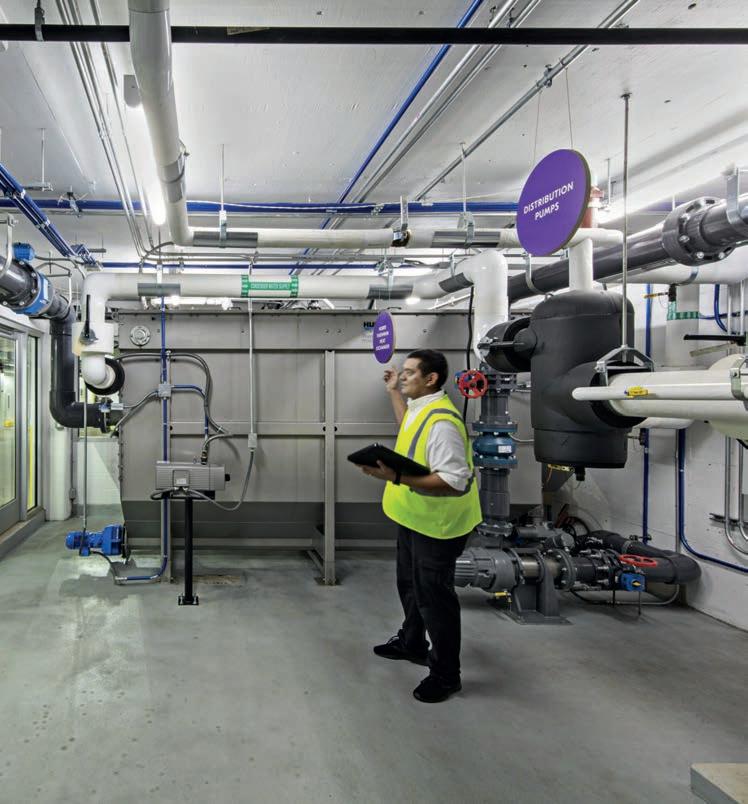
17 minute read
Power play
Electricity costs are up by 50%, gas, in some cases, by 120% – and estates, building services and FM teams are caught in the eye of the storm. How, then, to deal with 2022’s energy crisis?
First, should we even be in this position? Right now, decisionmakers – landlords, owner-occupiers, estates teams, FMs – are like the stranger asking directions from a local while out on a walk. Too often the reply is: “I wouldn’t start from here.”
David Stevens, vice-chair of the Chartered
Institution of Building Service Engineers’ (CIBSE) FM division, agrees. “That’s spot on. Before looking at the energy crisis itself, we need to consider what we are working with. Buildings are known to rarely perform as designed; the majority are seldom truly energy efficient. Despite great sector improvements there remains a performance gap between what is designed, what targets are set and how buildings really operate. What we have to focus on is reducing that performance gap.”
CIBSE has long campaigned for designing in greater resilience into new buildings, giving FMs a much more integral role in decision-making. Despite the warnings, the problem persists.
“Predictions about power shortages and cost rises have been in the media for some time, compounded by the risk of warmer
Dealing with a sudden and unprecedented energy crisis, FMs need to mitigate spiralling costs yet continue delivering the levels of service expected of them. But addressing these fundamental building performance issues means knowing where to start from, as Bill Dolsworth explains
ILLUSTRATION: STUART KINLOUGH / IKON summers and harsher winters,” Stevens argues. “The industry has long known the risks. There are solutions to combat exposure but in many cases they should already be in play.
“The decision [now] is how they might balance short-term measures and still consider the longer-term ideas requiring more capital expenditure.”
CIBSE’s Guide M for Maintenance Engineering and Management, a guidance document for those responsible for energy efficiency and maintenance delivery, points to an opportunity for the FM sector to demonstrate its role at the heart of the UK economy, Stevens believes – with now being an ideal opportunity.
“Gaining a sound understanding of how a facility is meant to operate at both a strategic and detailed level will identify areas of improvement,” says Stevens.
Applying solutions locally
All well and good. But what immediate steps can be taken? And how do you balance any such steps with the nascent decarbonisation agenda? In an ideal world, you wouldn’t start from here if you were hoping to minimise the impact of the energy crisis and decarbonise at the same time.
Andrew Holt, director, operational buildings at Hilson Moran, says the sector “needs to get a grip on the operational facts of current building or portfolio operation before it can appropriately map the correct path to decarbonisation”.
An immediate gap to fill is by addressing the all-too-frequent lack of engagement with the technical FM service providers who have the delegated responsibility for managing and controlling most of the high-energy consuming plant in a building. In this regard, Holt wonders if the
sector fully understands the scale of the challenge.
“As consultants, we are incredibly connected to the issues and the various industry initiatives aimed at meeting the challenge,” says Holt, “including government policy and work by the UK Green Building Council, the built environment professional network LETI and the Better Buildings Partnership. The challenge for the sector is in applying those high-level principles to often bespoke, practical and commercially acceptable solutions for the existing built environment.
“While there are common themes arising from our work for specific clients and individual buildings (see box, Checklist – energy reduction priorities), detailed solutions will invariably be tailored to each building and affected by building type, location, size, age, use, occupancy – and investment potential.”
The advice from Carl Brooks, global head of sustainability at CBRE, is: “Focus on the things you can control. Get that right and then look at the medium, say five-year plans covering repairs, replace

ENERGY BILLS
A BITTER BILL TO SWALLOW
Many businesses are overpaying on energy costs because they aren’t taking the time to check their bills and catch any errors or mistakes, argues Pradyumna Pandit, MD, Mitie energy and sustainability services.
He says that Mitie Energy’s bill validation team saved customers £4 million in the last financial year simply by checking all their energy bills were accurate.
Strong governance needs to be in place regarding the impact of pricing on energy procurement decisions, especially in these highly volatile times.
Having the right kind of agreement is important. A contract with additional flexibility, for example, being able to buy energy in smaller blocks, allows for not having all of your eggs in one basket. With a risk strategy in place, businesses can manage their price and volume risk and decide whether to bring in other purchasing routes, such as long-term power from power purchase agreements.
“With today’s price volatility, our advice is for businesses that can afford to hedge their energy bills at current levels to lock-in price stability now, as prices are likely to stay higher for longer. This offers certainty over costs for the medium term while other options to keep bills down are explored. Energy markets are complex and have many drivers, but ge ing it right pays dividends.”

PHOTOGRAPHY: ERIC LAIGNEL The American Geophysical Union building (above) in Washington DC includes the command center (below) a space designed specifically to educate guests about the energy control strategies in use throughout the building
AC/DC
FOR THOSE ABOUT TO TAKE STOCK
A legacy of Edison and Westinghouse’s ‘War of the Currents’ in 1880s America was the decision to use the less-efficient AC current instead of DC distribution in buildings. But now, factors have emerged that will allow FMs to reconsider the potential of DC in their future building design plans.
● The massive adoption of electronic/digital technology means we need DC more now; ● The rise of renewables and electrical energy storage (ESS) means we have more DC now; and ● The development of power electronics means we can now distribute DC to drive big appliances like refrigeration and HVAC more efficiently than with AC.
The technology isn’t yet ready to allow for designing or managing a building that only accepts DC at the point of supply. But what FMs can do now is specify infrastructure so that it is possible to plug DC energy from local assets directly into devices that need DC, without wasteful AC-DC conversion.
The principle is proven in DCexclusive buildings such as the Circl Pavilion in Amsterdam, while a good example of hybrid AC/ DC is the American Geophysical Union building (see pictures), which incorporates solar electric PV and DC controllers among a whole suite of passive and biophilic features.
When designing for DC ● Engage specialists who understand energy, construction and technology as a whole system; ● Design for DC from the start and from the ground up – the most important part is the infrastructure no one will ever see; and ● Involve all stakeholders in the journey; this includes your supply chain, particularly in the construction phase.

and any investment for operational expenditure. Then look at capex after that.”
For Brooks, identifying what form shortterm gain projects can take will have been made easier by two years of lockdown. Stevens concurs that for many, a new balance between office and home will have shifted some responsibility away from corporate buildings.
“Factories and production facilities cannot just close for a day or two,” accepts Stevens, “but an office can easily say to staff ‘you’re not coming in Tuesday and Wednesday’ and gain energy savings overnight – although this does transfer the energy responsibility to the homeowner.”
The rise of hybrid working has proved that productivity need not be affected by adapting the workplace, although how the workplace is managed can maximise energy efficiency and space at the same time. There are twin gains to be pursued: repurposing or even mothballing whole buildings or floors is one tactic, but a simpler one is to challenge the behaviours of end users and occupiers.
Amid ongoing concerns about corporate cohesion, hybrid working does allow for the potential hibernating of buildings when empty. Pradyumna Pandit, who is managing director of Mitie energy and sustainability services, says its work with clients has included helping to introduce behavioural change through ‘comfort policies’ for temperature and lighting settings. But Pandit also points to what if not already actioned must now be glaring opportunities; he estimates that Mitie helped customers to cut energy bills by 30% on average in 2020 by changing to LED lighting – much trailed – and by installing motion sensors, the latter leading to HVAC settings automatically adjusting based on












CHECKLIST
ENERGY REDUCTION PRIORITIES
Hilson Moran’s Andrew Holt offers the following advice: Top priority: ensure that there is sufficient metering and monitoring and use this data to derive a benchmark to understand what changes can be made to meet ambitious (but necessary) energy use intensity targets (as established by UKGBC) over the next few decades.
A note on heat pumps: Many people are latching on to the sound bite that heat pumps are the way forward. Subject to detailed feasibility, they are, but there are so many energy and carbon reduction priorities to focus on before jumping to plant replacement and new technologies.
These include: 1. Reducing energy consumption ● Are plant systems only operating when they are absolutely needed? ● Are system controls actually functioning as intended? ● Have you engaged with occupants to ensure that they understand their responsibilities? (eg, accepting broader temperature limits within their space, turning equipment off when not in use, and so on) ● Are KPIs for FM service providers being set and incentivised based on supporting client and occupier ESG, energy and carbon objectives? ● Is metered and other data being used to inform new operating strategies?
2. Specifying energy equipment and infrastructure ● In many instances improvements will have to be made to building fabric and air tightness before alternative technologies can be considered and deployed to their full potential. O en termed the ‘fabric first’ approach. ● Does the building have a fully considered and managed life cycle plan (PMR/FMR) to identify when existing plant, equipment and systems require replacement? ● Has the impact of lease breaks been considered in terms of opportunities to carry out and fund works? ● Does the client fully understand the significant and cascading implications of changing to new technologies? Taking the example of replacing boilers with heat pumps this is not simply a case of taking one out and pu ing the alternative in – namely, plug and play. Changing to a heat pump requires a detailed feasibility study to consider viability across multiple factors in the target building. ● The debate on the future of hydrogen as a viable solution for the built environment adds another dimension to be considered in helping clients decide on the right upgrade strategy for their buildings and por olios. We can only work with what we know today but nobody will thank us for recommending removing fossil fuel boilers and all the gas infrastructure to install heat pumps if, in five to 10 years’ time, hydrogen (however unlikely it looks today) in the gas network is viable and the gas infrastructure and boilers need to be put back in. ● Are clients prepared for the possibility that while every effort will be made to reduce energy consumption in the sizing of replacement plant, the payback may not be able to be judged in financial terms but purely in terms of improved carbon performance and building energy rating? ● The addition of other renewables to the building (eg, solar PV) must again be approached very carefully. Specifically for solar PV, aside from physical space and orientation, there are two key issues to consider. One is the embodied carbon in the manufacture, supply and installation of the renewable technology being added to the building. The second is that as the electricity grid gets rapidly greener, the carbon that is saved by solar PV becomes less relevant.

the number of people in the building. IoT laggards just might be able to show surprising cost cuts to their C-suites.
So, practical measures and behavioural change play a part. But ultimately “it’s still about measurement,” says Brooks. “We need data to understand what is going on and to then make tactical and strategic decisions. We still need to measure to manage.”
Simply use less
Chris Craggs, CEO of food equipment maintenance provider MCFT, says that there are lessons for everyone from his company’s work in the catering sector – and they’re mainly to do with swapping old for new.
This is where explanatory arguments with procurement must be won. Craggs suggests that the energy crisis has come along at the same time as a new generation of more efficient kit, making the old argument of a short-term cost being far outweighed by savings and efficiencies easier to make. The difficulty is in finding time to research and present the necessary business case.
“Kitchens are inherently energy inefficient not because of the equipment but because of how it is used,” begins Craggs. “I’d go as far as to say that there’s a flagrant misuse of power in most kitchens. A simple solution is to use more modern, efficient equipment – but use it less.” Likewise, simply using equipment more intelligently can cut operating costs. Says Craggs: “Kitchen operatives love switching everything on to prepare for service. But nowadays, systems are so good that ovens, grills and hobs do not need to be fired up hours before opening times. Kitchens are like everywhere else: we need to run stuff less.”
With this in mind, the checklist starts writing itself. Is the air-conditioning running overnight? Are the chillers at the right setting?
“Workplace management has
made significant use of movement sensors to track the usage of space,” says Craggs, “and the technology can be applied to how we use the energy in that space too. For example, in a kitchen we use sensors to track how often a fridge door is opened and how long it remains open, hence demanding more energy for its systems. Knowing this, we can encourage shifts in work patterns and reduce the movements of food from one cold storage to another to save energy.”
For those about to cook
If we can make savings by prompting behaviourial change, can we also find efficiencies in the technical form of power supply itself? Perhaps there are savings to be had here. Allan Burns, who sits on the Institution of Engineering and Technology’s built environment panel, says that it’s time to look at how buildings can be retrofitted to use less ‘alternating current’ (AC) electricity and more ‘direct current’ (DC) instead (See box, AC/DC – For those about to take stock).
“The vast majority of appliances in modern buildings use DC electricity,” explains Burns. “From the light bulb in the ceiling to the Tesla in the VP’s parking space, they all have to use devices to convert wavy ‘mains’ AC electricity into flat Direct Current (DC) electricity. These converters range from ubiquitous ‘wall-warts’ and ‘lumpin-lines’ which we can see, to powersupplies hidden in all digital devices like monitors.
“The characteristic they all share is that they waste energy as heat, typically between 10-20% and sometimes up to 40% where there are multiple conversions. That’s a massive potential saving. The adoption of electronic/digital technology in the past 20 years – IT, servers, you name it – means we need DC more now. It’s not easy, but FMs and building designers need to devise an infrastructure so that it will be possible to plug DC energy from local assets directly into devices that need DC, without wasteful AC-DC conversion.”
All of which is what Brooks might bracket under longer-term capex. And yet actually, it is already here, albeit in beta form. Burns and his IET colleagues are already testing the IET’s

own refurbished HQ in Stevenage. The reason he is advocating DC over AC is not because it is easy – it isn’t – but, he says, it should be considered “because it’s the right thing for the planet. And also, if it’s done right it will increase your ROI over the lifetime of the building.”
Time to get serious
The ‘quick wins’ may come through smaller equipment procurement cases; the longer-term gains may build on behavioural changes initiated in lockdown – but the energy crisis is a hard obstacle to handle. It’s worth starting from the premises that power prices, particularly for electricity, are always volatile and that an efficiencyfirst mindset should not be an optional one. Right now it is time to heed the lessons of how we reached this point – and to build policy and performance foundations to get through the current crisis and fix the focus on 2050.


THE BEST OF THE SECTOR’S DISCUSSION AND DEBATE VIEW POINT
38-39
Perspectives: Claudio Rojas, Vic O’Farrell, Dave Cairns and Julian Fris
40
Tamara Cruickshanks, Account Manager of the Year finalist in the 2021 IWFM Impact Awards
40
IWFM Chair Mark Whi aker invites eligible members to shape the Institute’s future
42-43
Amrit Tiwari and Fahim Saiyed offer us insights into their jobs

Where are we now?
Since the pandemic, there has been a shift in consumer behaviour, impacting retail trade turnover and profitability. Much of this has to do with the change to homeworking, which has continued post-pandemic. In addition to that, the shift to online purchasing has meant that influencing a consumers’ choice to visit a retail destination is more important now than ever. Furthermore, the prevalence of vacant unit space resulting from a major brand and independent traders’ collapse alters the landscape and perception of a town centre’s viability.
Where do we need to get to next?
We need to revitalise our town centres and retail destinations with a dynamic injection of alternate uses, while being mindful of the cost of operation. We must provide value for money for our occupiers yet still provide a safe and attractive environment for customers. For
Trading spaces
Changing consumer behaviour means reconsidering the use of retail space, says Mark Rycra
example, we reached out to Hartlepool Borough Council’s children’s services department and converted a vacant unit into an exciting alternative use for our community. Hartlepool Borough Council delivers integrated services for young children, carers, and families, focusing on closing the achievement gap for children from disadvantaged backgrounds.
How do we get there?
We need to lift the lid on our perceptions of retail places only being about retail. We need to review expenditure across all aspects of service delivery to ensure we provide a quality, value-for-money service; generate dynamic interest within the community by creating meeting places and spaces to build loyalty; but, more importantly, be flexible and open-minded. Seek out ideas and be bold in your thinking and approach.
MARK RYCRAFT is centre manager for JLL at Middleton Grange Shopping Centre










